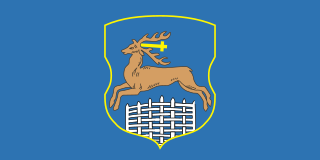
Grodno or Hrodna is a city in western Belarus. It is one of the oldest cities of Belarus. The city is located on the Neman River, 300 kilometres (190 mi) from Minsk, about 15 kilometres (9.3 mi) from the border with Poland, and 30 kilometres (19 mi) from the border with Lithuania. Grodno serves as the administrative center of Grodno Region and Grodno District, though it is administratively separated from the district. As of 2024, the city has a population of 361,115 inhabitants.
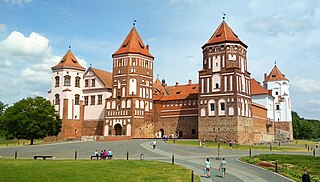
Grodno Region, also known as Grodno Oblast or Hrodna Voblasts, is one of the regions of Belarus. Its administrative center, Grodno, is the largest city in the region. As of 2024, it has a population of 992,556.

Pinsk is a city in Brest Region, Belarus. It serves as the administrative center of Pinsk District, though it is administratively separated from the district. It is located in the historical region of Polesia, at the confluence of the Pina River and the Pripyat River. The region was known as the Pinsk Marshes and is southwest of Minsk. As of 2024, it has a population of 124,295.

Tadeusz Kondrusiewicz is a Belarusian prelate of the Catholic Church who served as Archbishop of Minsk–Mohilev from 2007 to 2021. He has been a bishop since 1989, and from 1991 to 2007 held posts in Russia.

The Roman Catholic Metropolitan Archdiocese of Vilnius is an ecclesiastical territory or diocese of the Roman Catholic Church in Lithuania. Established as the Diocese of Vilnius in the 14th century, it was elevated to the rank of a metropolitan archdiocese by Pope Pius XI on October 28, 1925. It has two suffragan sees of Kaišiadorys and Panevėžys.

The House of Perkūnas is one of the most original and Gothic secular buildings, located in the Old Town of Kaunas, Lithuania. Originally built by Hanseatic merchants and served as their office from 1440 until 1532, it was sold in the 16th century to the Jesuits who had established a chapel there in 1643. The Jesuits have also completed the Church of St. Francis Xavier at the Town Hall Square in 1722.

St James's Cathedral is the Roman Catholic cathedral of Riga in Latvia. The cathedral is dedicated to Saint James the Greater. The building is part of the Old Riga UNESCO World Heritage Site and lies directly opposite the House of the Livonian Noble Corporation, the meeting place of Latvia's parliament the Saeima.

Cathedral of the Holy Name of Mary is a Roman Catholic baroque cathedral in Minsk. It is the seat of the Roman Catholic Archdiocese of Minsk-Mohilev.

The Old Grodno Castle in Grodno, Belarus, originated in the 11th century as the seat of a dynasty of Black Ruthenian rulers, descended from a younger son of Yaroslav the Wise of Kiev.

Church of the Blessed Virgin Mary was a Roman Catholic parish church in the city of Grodno. It was founded by Vytautas, Grand Duke of Lithuania before 1389 during the Christianization of Lithuania. Because of its founder, it was commonly referred to as Vytautas' Church. Rebuilt as a Gothic church around 1494, it was one of Grodno's principal Catholic churches until the post-World War II Soviet occupation. It was used by the Russian Orthodox Church since 1804 for roughly a century after the Catholic church was confiscated by the Russian Tsar. It was given back to the Roman Catholic Church during the interwar and World War II, except during the Soviet occupation of 1940–1941. Neglected in the aftermath of World War II, it was finally demolished in 1961.

The Holy Spirit Cathedral or the Holy Ghost Cathedral is a cathedral in Minsk, Belarus. Consecrated in honour of the Holy Spirit, it the mother church of the Belarusian Orthodox Church. It was built between 1633 and 1642 as a part Bernardine monastery during the Polish–Lithuanian Commonwealth in a place of former male Orthodox monasteries. The site became Orthodox again in 1860. The cathedral is listed as a Belarusian Cultural heritage object and is considered one of the main landmarks in Minsk Upper city.
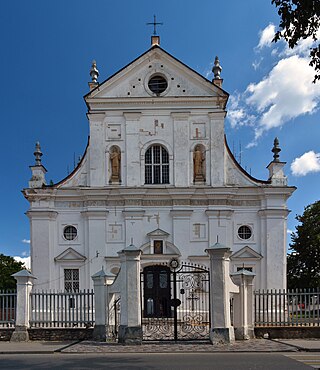
The Corpus Christi Church in Nyasvizh (Nesvizh), Belarus, is an early Jesuit church, and one of the oldest Baroque structures outside Italy, influencing the later architecture of Poland, Belarus and Lithuania. Commissioned by Prince Nicholas Radziwill and constructed between 1587 and 1593 by Gian Maria Bernardoni during the times of the Polish–Lithuanian Commonwealth, it contains tombs of powerful Radziwiłł family members.
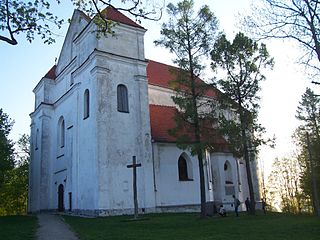
The Transfiguration Roman Catholic Church in Novogrudok, Belarus, is a Baroque church erected in 1712–1723, replacing an earlier Gothic building from the late 14th century, and originally consecrated under the title of Corpus Christi. Two Gothic chapels survive and are included in the Baroque building.
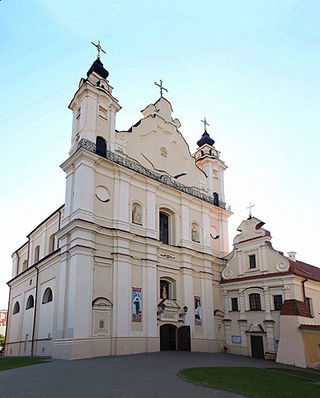
The Cathedral Basilica of the Assumption of the Blessed Virgin Mary also called Pinsk Cathedral, is an eighteenth-century Catholic Baroque-style temple in Pinsk, Belarus.

The architecture of Belarus spans a variety of historical periods and styles and reflects the complex history, geography, religion and identity of the country. Several buildings in Belarus have been designated as UNESCO World Heritage Sites in recognition of their cultural heritage, and others have been placed on the tentative list.

The Church of Charles Borromeo is a former Roman Catholic church in Pinsk, Belarus. Constructed between 1770 and 1782, it was consecrated in the name of St. Charles Borromeo, then reconstructed in the second part of the 19th century and dedicated to the Holy Trinity.
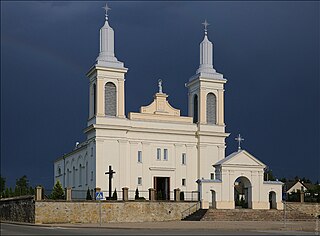
The Church of Saint Wenceslaus in Vawkavysk is a Belarusian Catholic church in the Grodno Region. Constructed in 1846–1848, it is now listed as a Belarusian national cultural heritage object.

The Vilnian Baroque or the School of Vilnius Baroque is a name of late Baroque architecture style in Catholic church architecture of the Grand Duchy of Lithuania, which expanded well into Greek Catholic church architecture on territories covered by the Union of Brest. The style was formed by alumnus of the Catholic Jesuits' Vilnius University. Most preserved buildings in this style are in Vilnius.





















